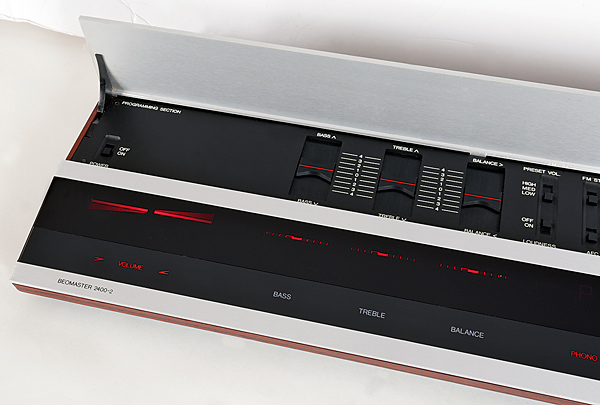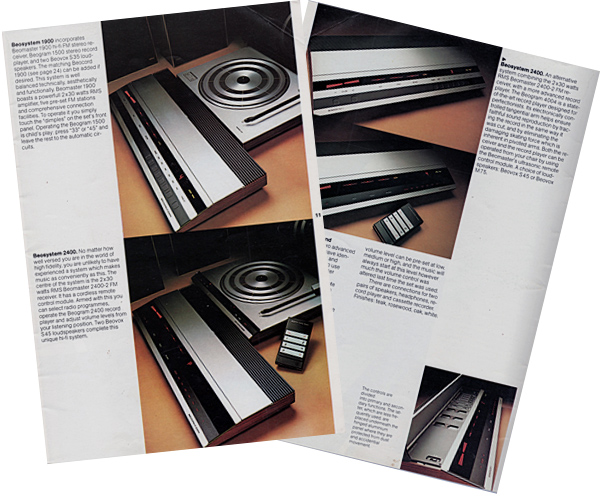B&O Beomaster 2400-2

 Combining cool cosmetics with touch-sensitive control, this late '70s receiver was a watershed when it came to the way we interact with our kit. How does it sound today?
Combining cool cosmetics with touch-sensitive control, this late '70s receiver was a watershed when it came to the way we interact with our kit. How does it sound today?
Released in 1977, B&O's Beomaster 2400 receiver brought touch-sensitive operation and full remote control to a world that expected nothing more from its hi-fi components than knobs and buttons. Its impact was immense, and soon the company's factory was unable to make receivers fast enough to satisfy demand. What's more, the unit's basic form and function lived on through a series of models that remained in production until 1992. And even by then, the design still looked fresh and modern.
The 2400 had been preceded a year earlier by the Beomaster 1900, which was essentially the same receiver without remote control. The launch publicity for the 1900 included a staged photograph of seven Japanese businessmen, dressed immaculately in black suits, crowding around and staring in wonderment at Denmark's latest electronic marvel. In fact, the Beomaster 1900 and 2400 had been planned and designed together, but the 2400 was delayed in order to ease the load on B&O's hard-working factories.

Touch Of Class
What set the 1900 and 2400 apart from all previous hi-fi designs was the absence of any visible mechanical controls. Designer Jakob Jensen had divided the functions up into 'primary' and 'secondary' groups, the former being accessible on the main panel with the latter hidden under a hinged lid on the top of the receiver. The primary controls comprised touch pads for source selection, volume control and power off, the set being switched on from standby when a source was selected. To make this easy, five of the sources were pre-tuned radio programmes on the FM band, the remaining two being assigned to a record player and a cassette recorder.
Also present on the primary operating panel were light displays for all functions. The volume display used two large red icons shaped as wedges with the difference in brightness between them denoting the setting. The treble, bass and balance settings were shown by what looked like LED bar graphs but were in truth a clever optical trick involving bulbs, filters, transparencies and lenses. The selected source was shown in red text next to the relevant sensor and the accuracy of the radio tuning was indicated by the balance of the intensity of two small green lights. The word 'stereo' appeared in green when a stereo broadcast was being received.

Fat Controller
The secondary controls included treble, bass and balance, loudness compensation, AFC and stereo/mono selection for the tuner section. The tuning controls were also hidden beneath the lid, with four small dials for positions 1 to 4 and one larger one that could be used for 'free tuning' between infrequently used stations.
The 'Beomaster Control Module' remote control unit supplied with the Beomaster 2400 used ultrasonic signals to send commands to the receiver, unlike today's handsets, which use infrared. The available operations were volume up and down, radio presets 1 to 4, turntable and standby. B&O's ultrasonic remote control method was particularly effective since it used a mixture of two frequencies to define each function. Both had to be present at the correct intensity in order for the receiver to respond.
In 1978, both the Beomaster 1900 and the 2400 were updated to become the 1900-2 and 2400-2 respectively, the key improvement being that the volume control now had 32 levels instead of the previous 16. The Beomaster 2400-2 also gained the ability to start and stop a B&O turntable either via remote control or by touching the panel. Models suitable for this had numbers ending in a '4', the most desirable being the big tangential-tracking Beogram 4004, which was similar to the Beogram 4000 [HFN Jun '14]. The Beocord 1900 was the matching cassette recorder for all versions, until the introduction of metal tape when it was replaced by the mostly new, but outwardly near identical, Beocord 2400.
Production of both Beomaster models ended in 1981 as the new 2000 and 3000 were being prepared. These employed microprocessors to fully interact with a new range of turntables and tape recorders and the 3000 had infrared remote control, but their introduction was delayed by a year. This resulted in the brief appearance of a stop-gap model, the Beomaster 2300. This was essentially a Beomaster 1900-2 with the appearance of the 2400. It was not a big success.

Encountering the slim Beomaster 2400-2 receiver today is still a delightful experience. At just 6cm tall it is slender indeed, and just like those futuristic Citroën cars of that era, it still manages to make its more modern equivalents look old-fashioned. The touch sensors work with a slickness and precision that would make an iPad user of today green with envy and ergonomically it is difficult to fault overall. True, the plastic slide switches and controls under the cover are perhaps less impressive, some having a stiff and jerky action, but for all the sophistication which lies beneath, this is a very easy piece of equipment to operate.
Power A'plenty
The optical bargraph displays for treble, bass and balance are fascinating to use and it's hard to believe that they simply comprise a printed pattern on clear plastic. The remote control works well too and at no time would you think that it wasn't a modern system using infrared transmission and digital codes. Connections are via B&O's preferred DIN standard sockets, which presents no problems even if you partner the Beomaster 2400-2 with non-B&O sources and speakers since suitable adapters are widely available. One potential pitfall is that the recording output suits DIN-standard equipment only, which means it's insufficient for recorders that require (higher) line-level signals. B&O did issue a modification for this, but it requires workshop attention to implement.
The amplifier section of the Beomaster 2400-2 is DC-coupled to the loudspeakers and rated at 2x30W into 8 and 4ohm [see PM's Lab Report, p127], so the receiver should be more than powerful enough for most listening needs. The phono stage is optimised for B&O's own cartridges, but these are sufficiently similar to standard MM types for there not to be a problem if you wish to use a non-B&O turntable.























































